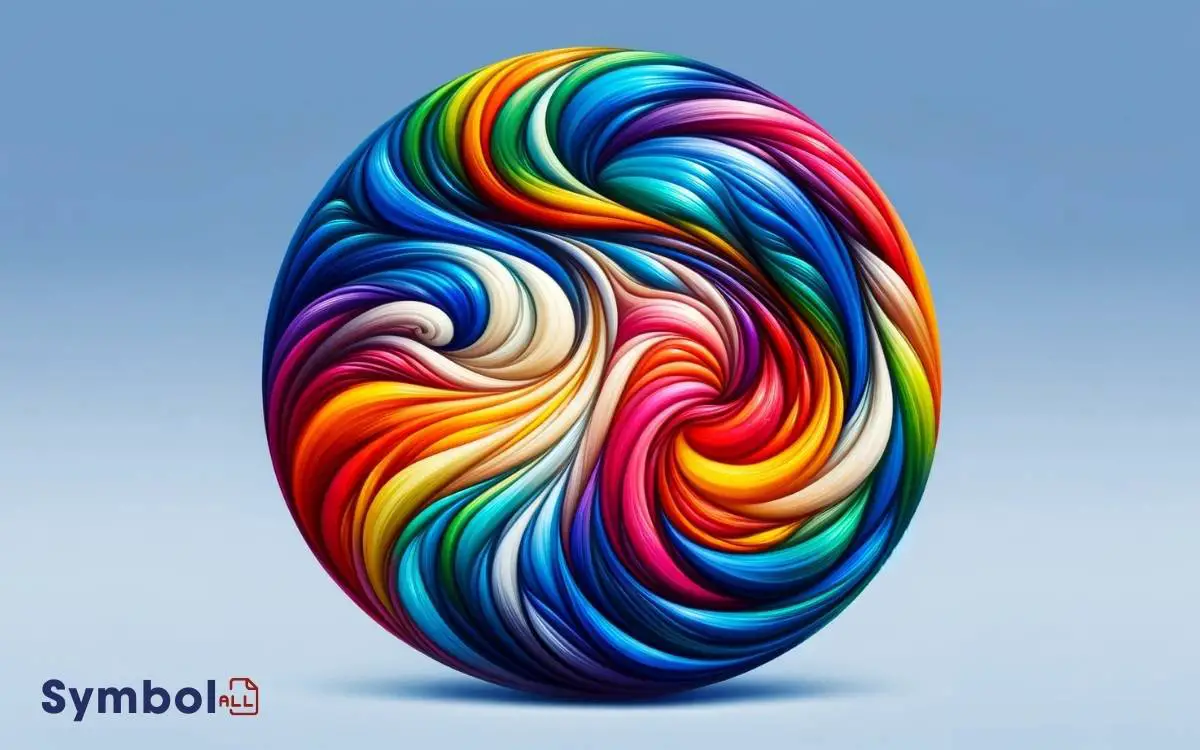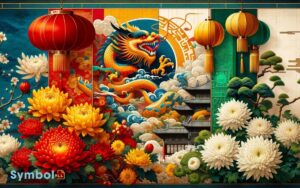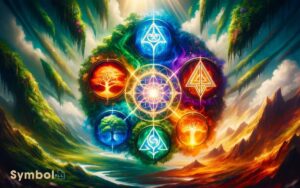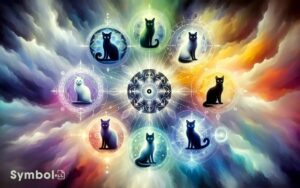What Do the Colors of the Rainbow Symbolize? Explained!
The colors of the rainbow carry deep meanings that transcend visual beauty. You find red evoking passion and danger, while orange bursts with creativity and joy.
Yellow, akin to the sun’s radiance, brings vitality and hope, contrasting the calming tranquility of green, which symbolizes growth and renewal.
Blue, drawing you into vast calming spaces, promotes tranquility. Together, these colors form a tapestry of cultural narratives and emotional connections, varying across societies.
They reflect not just the natural world but human emotions, spirituality, and the cycle of life itself. Unpacking these colors, you’ll unearth a world brimming with symbolism and interconnectedness.

Key Takeaway
Rainbow Colors and Their Symbolic Meanings
| Color of the Rainbow | Symbolic Meaning |
|---|---|
| Red | Passion, vitality, enthusiasm, and security |
| Orange | Creativity, adventure, enthusiasm, success, and balance |
| Yellow | Happiness, hope, and spontaneity |
| Green | Nature, growth, harmony, and fertility |
| Blue | Stability, trust, loyalty, wisdom, and confidence |
| Indigo | Intuition, perception, and the greater understanding |
| Violet | Spirituality, luxury, ambition, and personal growth |
The Significance of Red
While exploring the vibrant spectrum of rainbow colors, it’s essential to investigate how red, often symbolizing passion and danger, uniquely influences cultural expressions and individual perceptions across diverse societies.
In many cultures, you’ll find that red isn’t just a color; it’s a powerful symbol that weaves through rituals, traditions, and daily life.
For instance, in some Asian societies, red is the color of prosperity and joy, playing a central role in weddings and New Year celebrations.
Conversely, in Western contexts, red can signal caution or attract attention, embodying both love and aggression.
This duality of red, embodying both life’s most intense emotions and its most pressing warnings, illustrates the depth of its impact on human experience, proving that its significance is as varied as it’s profound.
Orange: Creativity and Joy
Orange bursts onto the scene as a vibrant herald of creativity and joy, embodying the warmth and energy that inspire cultures around the globe.
This hue, sitting between the fervor of red and the cheerfulness of yellow, captures the essence of autumn’s richness and the invigorating sunsets that paint the sky.
In many societies, orange symbolizes a dynamic creativity, encouraging self-expression and the sparking of artistic visions.
It’s seen in the marigolds of a Dia de los Muertos altar, symbolizing a joyful reunion with the departed, and in the robes of Buddhist monks, representing a commitment to a life of simplicity and spiritual richness.
Through its vivacious presence, orange invites you to embrace spontaneity, nurturing an environment where joy and creative spirits flourish.
Yellows Warmth and Energy
Yellow captures the essence of the sun’s radiance, infusing life with vitality and energy that resonates across cultures.
You’ll find its vibrant presence not just in nature but also within the tapestries of human tradition, where it often symbolizes joy, vitality, and hope.
Analyzing its cultural significance, yellow’s energy is universally acknowledged, yet its interpretation can vary dramatically from one culture to another.
| Culture | Symbolism | Usage |
|---|---|---|
| Western | Happiness | Celebration Decor |
| Asian | Sacred, Royal | Temples, Palaces |
| Middle East | Wisdom, Wealth | Art, Literature |
| African | Fertility, Beauty | Clothing, Festivals |
| South American | Courage, Strength | Folk Art, Murals |
Green: Nature and Harmony
As you explore various cultures, you’ll notice how green symbolizes growth and renewal, mirroring the natural cycles of the earth.
It’s a color that brings balance and stability, seen in the rituals and traditions that celebrate the harmony of nature. It’s often associated with warmth and connection, bridging the energy of orange and the softness of pink. The meaning of the color coral extends beyond its vibrant hue, symbolizing renewal and a sense of calm. Whether adorning nature’s reefs or inspiring artistic creations, this shade captivates the heart while evoking a sense of grounded beauty.
Growth and Renewal
Green, often associated with growth and renewal, symbolizes the seamless progression of nature through cycles of rebirth and harmony.
This color embodies the sprouting of seeds into flourishing life, reflecting the inherent connection between the earth’s fertility and its capacity to nurture.
Across cultures, green signifies the awakening of the earth after winter’s slumber, a universal reminder of life’s resilience and the promise of new beginnings.
It’s the hue of sprouting leaves and budding flowers, each a confirmation of nature’s ability to regenerate and sustain itself.
This symbolism isn’t just rooted in the observable world; it permeates human traditions, where green often marks periods of renewal, whether in festivals celebrating spring or in personal moments of growth and self-discovery.
Balance and Stability
Delving into the essence of green, we find it not only encapsulates growth but also stands as a confirmation to balance and stability, harmonizing nature’s diverse elements. This color, deeply rooted in the imagery of the natural world, signifies a state of equilibrium.
It’s where the essence of the earth meets the tranquility of the sky, creating a midpoint that fosters life.
In various cultures, green embodies the steadfastness of the earth—unchanging and reliable. It’s seen in the steadfastness of evergreens, symbolizing life’s continuance amid seasonal shifts.
This color’s presence in our surroundings reassures us, offering a visual cue of the natural world’s enduring stability amidst human-induced chaos, reminding you that balance isn’t only achievable but inherently present in the natural order.
Peace and Tranquility
Exploring further, we find that green not only signifies balance but also envelops us in an aura of peace and tranquility, resonating with nature’s inherent harmony.
As you investigate more deeply into the symbolism of green, you’ll discover its profound connection to a sense of well-being that transcends cultural boundaries.
Consider these aspects:
- In many cultures, green is the color of renewal, symbolizing the rebirth of nature in spring.
- It’s often associated with safety, prompting feelings of security and comfort.
- Green spaces in urban environments are linked to reduced stress and improved mental health.
- Traditional healing practices worldwide use greenery to promote healing and balance within the body.
This color’s universal appeal lies in its ability to mirror the natural world, offering a sanctuary of peace amidst life’s chaos.
The Calm of Blue
As you explore the tranquility blue evokes, you’ll find its peaceful essence is universally cherished, transcending cultural boundaries and fostering a sense of serenity.
In many societies, azure tones inspire creativity, symbolizing a vast, unexplored sky or a deep, mysterious sea.
This color’s ability to calm and stimulate thought simultaneously reveals its complex role in human perception and cultural expression.
Blues Peaceful Essence
Blue’s tranquil essence often brings a sense of peace and calm to those who gaze upon it, reflecting its deep cultural and psychological significance across various societies.
It’s not just a color; it’s an emotion, a state of mind that transcends beyond the visual spectrum into the domains of the spiritual and the subconscious.
Here’s why:
- Symbol of Serenity: Blue is universally recognized as a calming force, often associated with the sky and the sea, vast spaces that evoke a sense of freedom and serenity.
- Cultural Significance: Across cultures, blue holds a sacred place, symbolizing trust, loyalty, and wisdom.
- Psychological Impact: It’s known to reduce stress, providing a soothing effect that fosters mental clarity and emotional stability.
- Spiritual Connection: In many spiritual practices, blue is considered conducive to meditation and spiritual enlightenment, facilitating a deeper connection with the self and the universe.
Creativity in Azure Tones
Building on the serene foundations of blue’s psychological impact, let’s examine how its azure shades inspire unparalleled creativity.
You’ll find that across cultures, azure evokes a sense of spaciousness and freedom, conditions under which creativity flourishes.
This isn’t just a matter of aesthetics; it’s deeply rooted in how societies perceive and interact with the color blue.
Historically, azure has been associated with the infinite possibilities of the sky and sea, leading to its symbolic connection with exploration and innovation. Artists and thinkers are often drawn to this color, using it as a muse for their work.
It’s as if the calmness of blue provides a canvas for the mind, allowing thoughts to wander and innovate without bounds.
Azure doesn’t just represent creativity; it actively fosters it, encouraging you to look beyond the horizon and imagine what could be.
Indigo: Intuition and Perception
Indigo, often associated with profound intuition and heightened perception, invites you to explore the unconscious territories of your mind.
This deep, rich color resonates with those who seek to understand the unseen, guiding you through the shadows of your psyche to illuminate insights previously obscured.
Here’s how indigo influences you:
- Enhances Intuition: It sharpens your inner knowing, allowing you to trust your gut feelings.
- Deepens Perception: Indigo opens your eyes to subtleties, enriching your understanding of complex situations.
- Encourages Reflection: It invites introspection, leading to profound personal insights.
- Strengthens Connection: By tuning into indigo’s frequency, you align more closely with the universe’s vibrations, enhancing your spiritual connectivity.
Embracing indigo’s essence fosters a deeper connection with your inner wisdom, offering clarity and guidance on your journey through life.
Violets Spiritual Depth
Violet’s spiritual depth offers a profound connection to the divine, encouraging you to explore the mysteries and wisdom that lie beyond the physical domain.
This color, often associated with the crown chakra, represents a bridge to spiritual enlightenment and inner strength. Its presence in various cultures symbolizes a quest for deeper understanding and the embrace of intuition.
| Aspect | Significance | Cultural Insight |
|---|---|---|
| Crown Chakra | Spiritual connection & enlightenment | Universal quest for wisdom |
| Inner Strength | Resilience in the face of challenges | Valued across cultures |
| Intuition | Inner knowing beyond logic | Celebrated in spiritual practices |
| Enlightenment | Ultimate understanding & peace | Sought in many philosophical traditions |
Violet invites you to look inward and upward, seeking a connection that transcends the tangible.
Pink: Love and Kindness
As you explore the nuances of pink, you’ll find it universally embodies love and kindness, serving as a gentle reminder of compassion and nurturing in cultures around the world.
Here’s how pink manifests its gentle power:
- In Japan, pink cherry blossoms are a symbol of life’s ephemeral beauty, encouraging mindfulness and appreciation.
- Among the Indigenous peoples of North America, pink is often used in art and attire to denote femininity, youth, and care.
- In Thai culture, pink is associated with Tuesday and is thought to bring good luck when worn on this day, reflecting a unique blend of tradition and superstition.
- In contemporary Western societies, pink ribbons are synonymous with breast cancer awareness, symbolizing hope, support, and solidarity in the face of adversity.
Pink’s gentle hue invites you to reflect on the universal values of love and kindness, weaving a thread of empathy and understanding through the tapestry of human culture.
The Mystery of Black
Delving into the depths of black reveals a color that’s as intricate as it’s alluring, embodying a range of meanings from mourning and mystery to elegance and empowerment across cultures.
In many societies, black symbolizes the end, yet it also represents a beginning, a canvas upon which new ideas and identities are projected. It’s a color that absorbs all others, holding within it the secrets of the universe and the unknown.
Fashionably, black conveys sophistication and timelessness, a staple that transcends seasonal trends.
Culturally, it’s a marker of solemnity and profound respect during periods of mourning, yet it also stands as a powerful emblem of resistance and strength.
This duality captures the human experience, reflecting our deepest fears and our greatest aspirations.
White: Purity and New Beginnings
In cultures around the globe, white symbolizes purity and marks the promise of new beginnings. This color, often seen as a blank slate, carries significant meanings across different societies.
Its symbolism extends into various dimensions of life and culture, offering a universal language of renewal and innocence.
Consider these aspects of white’s symbolism:
- Weddings: In many cultures, white is the color of bridal dresses, symbolizing purity and the start of a new chapter.
- Peace and Harmony: White flags or doves as symbols of peace highlight the color’s association with harmony and fresh starts.
- Spiritual Practices: In several religions, white garments represent purification rituals or significant life milestones, emphasizing renewal and spiritual cleansing.
- Seasonal Changes: The first snowfall, often seen as a blanket of white, signifies winter’s arrival and nature’s cycle of rebirth and rejuvenation.
Understanding white’s multifaceted symbolism enriches our appreciation of its role in heralding new beginnings and purity across the globe.
Gold: Prosperity and Wisdom
Moving from the symbolism of white, we now explore how gold embodies prosperity and wisdom across various cultures.
In your journey to understand color symbolism, you’ll find that gold, with its lustrous allure, has universally signified wealth and success.
It’s not just about material riches; gold symbolizes the achievement of spiritual enlightenment or the quest for knowledge in many societies.
Ancient civilizations revered gold for its perceived connection to the divine, believing it possessed the power to enlighten one’s mind.
In addition, in rituals and art, gold represents a higher understanding and respect for the cosmos. Its presence in cultural artifacts and religious symbols serves as a confirmation of humanity’s enduring quest for prosperity and wisdom.
This deep-seated association invites you to reflect on gold’s dual nature, intertwining tangible wealth with the intangible wealth of knowledge.
Silver: Reflection and Innovation
You’ve encountered silver’s gleam in countless cultures, where it acts as a mirror of modernity, reflecting societal advancements and technological progress.
This color encourages you to view the world through a lens of innovation, serving as a catalyst for creativity that pushes boundaries and challenges conventional thinking.
In exploring silver’s symbolism, you’re engaging with a narrative of transformation and the relentless pursuit of the new.
Mirror of Modernity
Silver’s sheen mirrors the essence of modernity, reflecting society’s relentless pursuit of innovation and change.
In every corner of the world, silver’s symbolism varies, yet it consistently represents the future, technology, and the streamlining of our daily lives.
Here’s how:
- Technology and Progress: Silver is synonymous with cutting-edge tech, from sleek smartphones to electric cars.
- Urbanization: It embodies the color of towering skyscrapers and the urban jungle’s metallic heartbeat.
- Globalization: This color signifies the interconnectedness brought about by modern communication tools.
- Sustainability: Despite its industrial feel, silver is increasingly linked with renewable energy sources like solar panels.
Catalyst for Creativity
Reflecting society’s penchant for innovation, silver not only embodies technological progress but also serves as a catalyst for creativity across various cultures.
In your exploration of its significance, you’ll find that silver’s reflective quality isn’t just literal; it mirrors the human capacity for thought and invention.
Cultures around the globe have long associated silver with the moon, linking it to the ebb and flow of creativity and inspiration.
This connection isn’t coincidental but deeply rooted in how societies perceive and interact with the world.
Silver’s luster sparks imagination, urging you to look beyond the surface and consider what could be.
It’s a color that doesn’t shout but whispers, encouraging introspection and innovative thinking. In this light, silver becomes more than a color; it’s a symbol of human ingenuity.
The Rainbow as a Whole
In various cultures around the world, the rainbow serves as a powerful symbol, embodying promises, diversity, and renewal.
When you look at a rainbow, you’re not just seeing a beautiful arc in the sky; you’re witnessing a symbol that has deep roots in human history and spirituality.
Here’s what the rainbow represents as a whole:
- Unity: Despite the different colors, they form a harmonious whole.
- Hope: Often appearing after rain, it symbolizes the end of difficult times.
- Bridge: In many myths, it’s seen as a connection between the earthly and the divine.
- Cycle: Its circular shape symbolizes the cycle of life, encompassing birth, growth, and renewal.
Understanding the rainbow in this way invites you to appreciate its full cultural and symbolic significance.
Conclusion
In the tapestry of life, you find the dynamism of a rainbow weaving through your experiences. Red pulses with energy, while orange splashes creativity across your canvas. Yellow beams with hope, and green cradles you in nature’s embrace.
Blue serenades with calmness, white whispers of new beginnings, and gold and silver, those twins of prosperity and innovation, enrich your path.
This chromatic symphony isn’t just a feast for the eyes; it’s a reflection of humanity’s dance with emotions, cultures, and aspirations.
Together, they paint a universe where every hue sings in harmony, celebrating the diversity and unity of our shared human journey.






